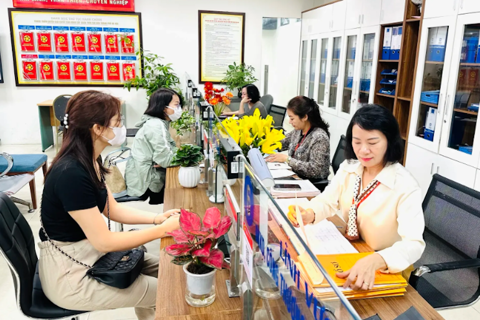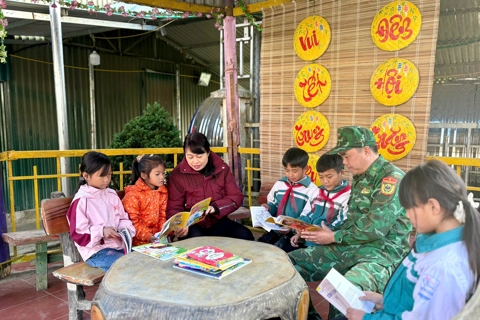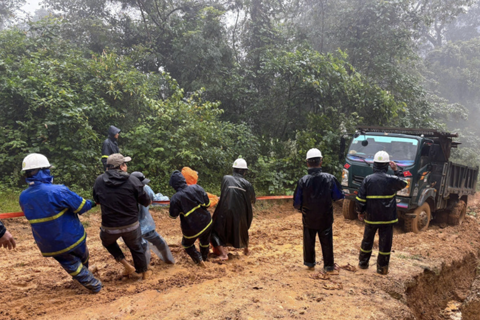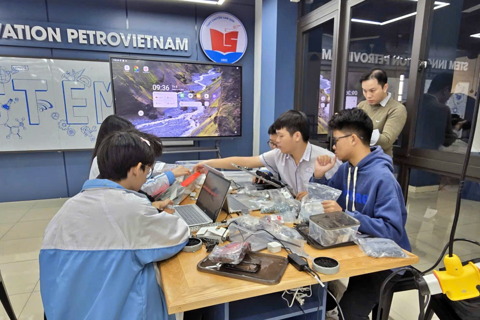Unsung heroes on a mission to rescue To Lich River
Hanoi not only needs some unspoken heroes, who are trying to clean To Lich River, but also the whole efforts of the community to save the historical, symbolic waterflow of the city.
THE HANOI TIMES — On a summer evening in late April 2025, a team from the Hanoi Drainage Company began their routine work.
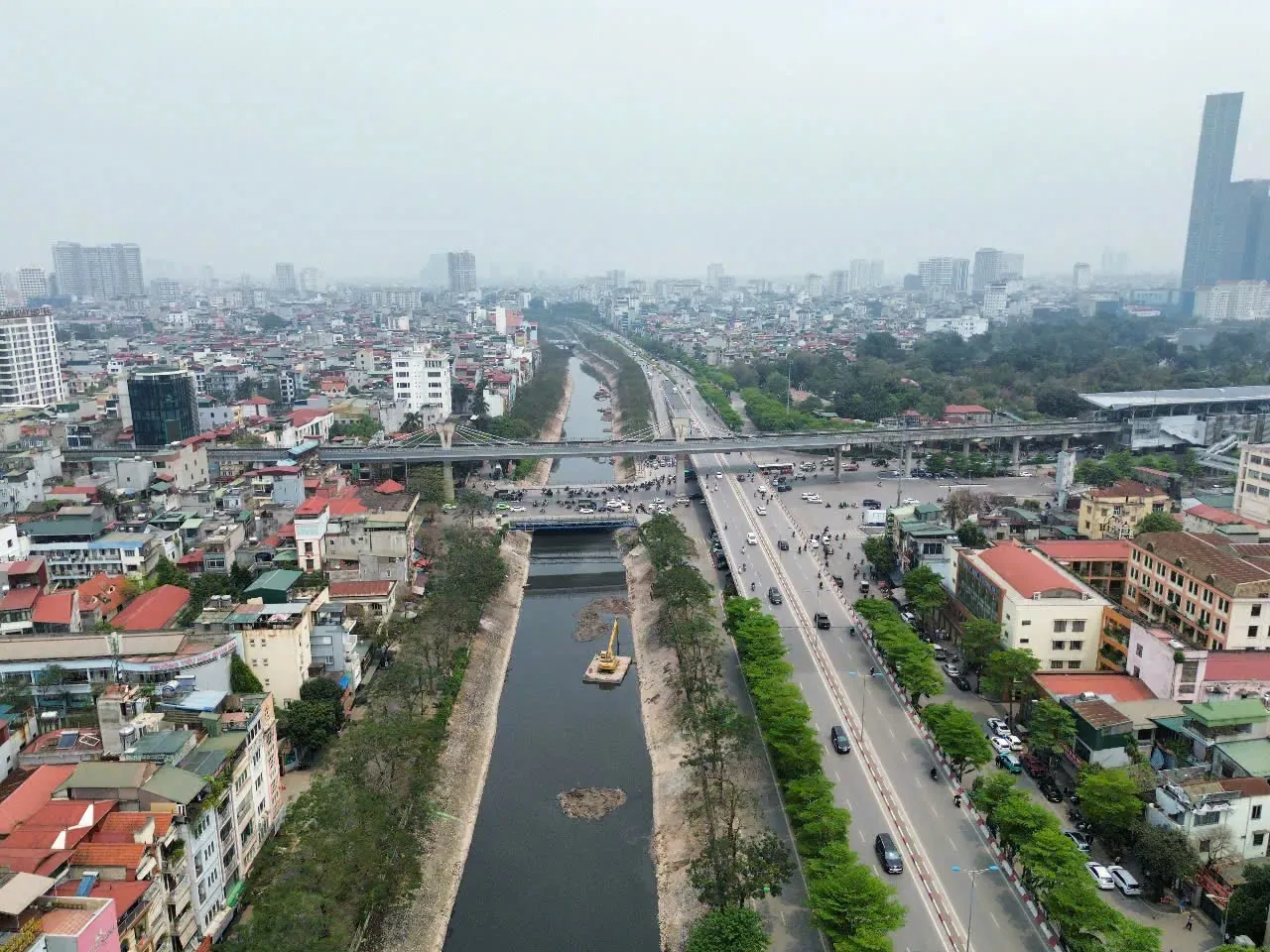
To Lich River in Hanoi. Photo: Kinh te & Do thi Newspaper
The equipment was already in place. Under the faint reddish glow of streetlights, groups of workers split up for different tasks. One operated the suction machine on land, another steered the excavator dredging the riverbed, while others worked with suction hoses in the storage tanks on the river.
Each had a specific job. With little exchange of words, their actions were seamlessly synchronized, as if directed by an invisible conductor. The light from the excavator bounced off the surface of the river, and the roar of the dredge and suction machines was deafening.
In this scene, team leader Phan Ky San stood out, barking out orders in a deep, commanding voice.
Born in Haiphong in 1971, San joined the Hanoi Drainage Company in 1992 after three years of freelance work. Since then, he has devoted 33 years to his career in drainage.
"When I first joined, I worked in the underground sewer division for nine years. Then I moved to the Mechanical Construction Enterprise, where I’ve worked ever since," San told The Hanoi Times.
In over three decades in the industry, San has experienced countless emotions and memories, from working in underground sewers to braving freezing winter temperatures to remove waste and sludge, and none of them are forgettable.
"The challenges of this job are endless, but the biggest concern is urbanization," San said.
As Hanoi rapidly urbanizes, lakes and ponds have disappeared or shrunk, and most sewage and garbage are being dumped into rivers, threatening to clog the waterways.
For workers like San, the biggest nightmare of river cleanup isn't just the sewage, but the overwhelming amount of garbage.
He recounted with dismay that about ten years ago, when they were cleaning a sewer, originally a canal, in Van Phuc Ward, Ba Dinh District, it was clogged with garbage.
"The garbage formed a patch so solid that someone weighing 50-60 kilograms could walk on it like solid ground without sinking. I estimated it to be over a meter thick, filled with all kinds of imaginable trash," San recalled.
It took San and his colleague more than a month to remove the garbage and restore the sewer's flow. Even now, he shudders at the memory.
"When I first saw the state of the canal, I was stunned. When we finished, it still felt surreal that we had cleared it."
Unlike San, Nghiem Van Huynh, who leads another team in the Mechanical Production Division, took a different route into the drainage industry.
Huynh first worked in construction for many years. In 1987, he decided to take an excavator operator training course, a decision that would turn his career around.
After graduating in 1991, Huynh worked for a construction materials company, traveling around the country for projects. While the job offered a better income, the constant travel took a toll on his health.
In 1998, a friend at the Hanoi Drainage Company suggested he change careers. Huynh accepted and joined the drainage industry.
At his new job, Huynh realized that bringing modern machinery to the job could greatly improve productivity. He began researching and eventually invented a unique float system for excavators.
This float system allowed excavators to operate and move easily on water, dredging riverbeds and transferring sludge to boats before being sucked to shore.
Huynh's invention revolutionized dredging, replacing manual labor, and greatly increasing efficiency.
Today, these specialized floats are essential in all of the company's river and lake dredging projects, including the To Lich River cleanup.
"In any field, technology and modern machinery are crucial. I'm happy that my small contribution has made our work more efficient and contributed to the restoration of the To Lich River," Huynh said.
In late April and early May 2025, Nguyen Khang Street from the Tran Duy Hung intersection to the Cau Giay area was busier than usual.
Yellow special vehicles from the Hanoi Drainage Company lined the streets as workers in bright yellow uniforms hurriedly prepared machinery and equipment to dredge the To Lich River.
For months, these workers have been dredging sludge from the river to restore this historic waterway.

An excavator working on the surface of the To Lich River.
The operation is a true battle against time, nature, and mounting difficulties. The company has deployed all its resources, including excavators, barges, and modern vacuum trucks, to tackle the massive build-up of sludge that has accumulated over decades.
According to the approved plan, about 40,000 cubic meters of sludge will be dredged by August 2025. This ambitious target demonstrates the scale and importance of the project, which requires seamless coordination between people and machines to meet the deadline.
Once sludge is removed, it must be carefully transported and processed to avoid harming the surrounding environment. Workers and engineers also follow strict safety regulations while dealing with challenges such as geography and weather.
The Mechanical Construction Enterprise is the backbone of this campaign.
San revealed that during the To Lich River cleanup, the workers often received gifts from residents, such as fruit, sticky rice, or bottles of water.
"These small tokens and words of encouragement from people motivate us a lot," San said. "It makes us proud to contribute to the revival of this historic river."
Community, authorities need to join the effort
While workers like San and Huynh are unsung heroes, they are not alone in this fight.
Hanoi has taken several steps to restore the To Lich River, but experts stress that stopping the flow of sewage into the river is essential to keeping its water clean.
The city has announced plans to transfer clean water from West Lake and the Red River to the To Lich River. By August 2025, water from West Lake will flow into the To Lich River, while the city is considering replenishing it with water from the Red River via Vo Chi Cong Street to ensure a stable, long-term water supply.
Another key project is the construction of a dam near Quang Bridge in Thanh Tri District to stabilize water levels during the dry season. Experts believe that this multi-purpose solution will not only help revitalize the To Lich River but also improve flood management in urban areas.
For these efforts to be successful, however, the wastewater must be treated before it enters the river. Otherwise, the dam could trap pollutants, making the situation worse.
Most importantly, residents must stop dumping waste into the river.
"The government can do a great job, but if people don't change their habits, the river will remain polluted," said Le Minh Tuan, a resident of Dong Da District.
Nguyen Van Thanh, who lives near the river, added: "Cleaning the river and adding fresh water isn't enough. The key is to stop littering and dumping. The authorities need to impose stricter penalties on perpetrators."
Nguyen Van Hien, a retired official from Thanh Xuan District, agreed: "Bringing clean water from West Lake and the Red River is a good idea, but without wastewater treatment, the effort will be wasted. The city must enforce strict monitoring and transparent management."




